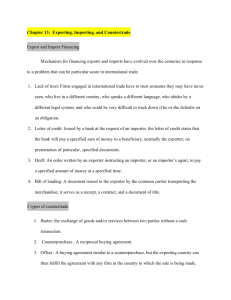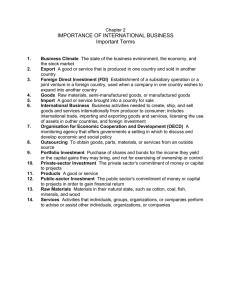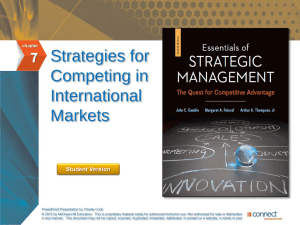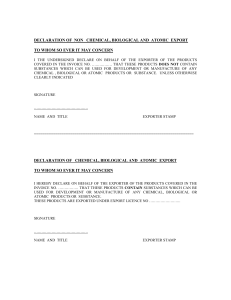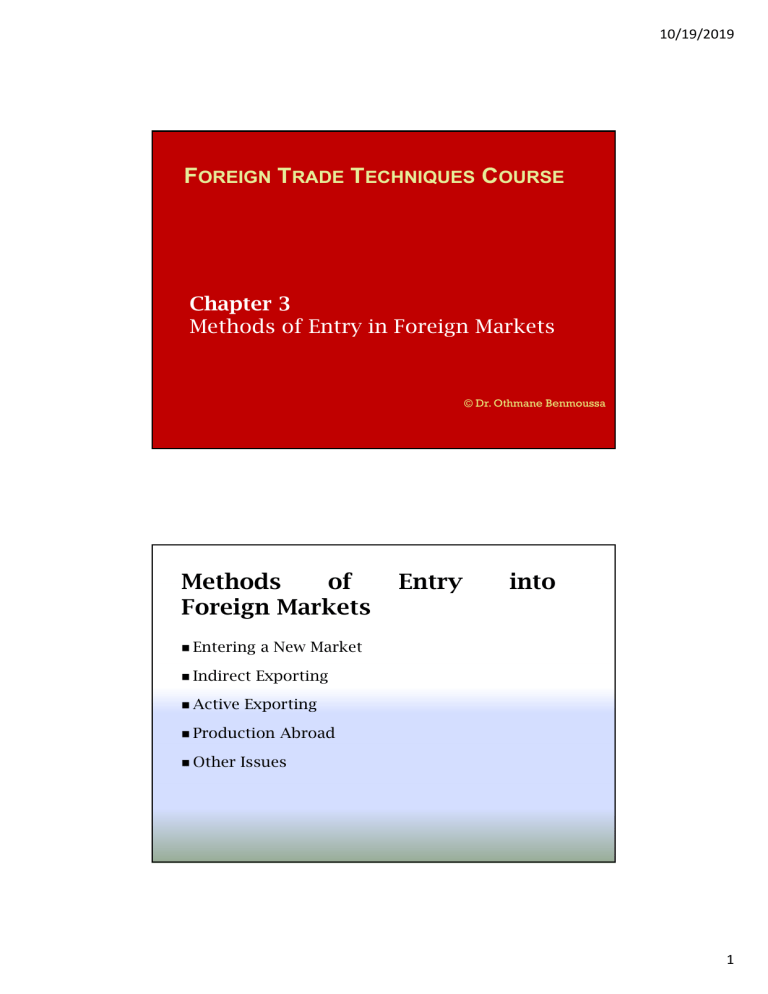
10/19/2019 FOREIGN TRADE TECHNIQUES COURSE Chapter 3 Methods of Entry in Foreign Markets © Dr. Othmane Benmoussa Methods of Foreign Markets Entering Indirect Active into a New Market Exporting Exporting Production Other Entry Abroad Issues 1 10/19/2019 Entering a New Market The determination of the appropriate method of entry in a new market depends on several factors: Size and growth of the market Potential market share of the exporter Type of product and marketing strategy of the exporter Willingness of the exporter to get involved Characteristics of the importing country Time horizon considered Entering a New Market The company must decide whether market factors favor Manufacturing at home Indirect Exporting Manufacturing abroad Active Exporting 2 10/19/2019 Entering a New Market Active Exporting Indirect exporting Exporter does export sales. not seek Allows manufacturer to concentrate on domestic market and leave exporting to the experts. Exporter actively participates in finding potential markets abroad. Best option for large firms or firms with international experience. Indirect Exporting Export Trading Companies Export Management Corporations Piggy Backing 3 10/19/2019 Export Trading Company An Export Trading Company [ETC] is a firm with offices in multiple countries that purchases goods in one country and resells them in another. For the “exporter” selling to the ETC, as well as for the “importer” buying from the ETC, the transactions are domestic transactions, even if the goods eventually travel internationally. Historically, the first ETCs were created in Britain, France, and the Netherlands to facilitate trade with India and Indochina. They were then created in Spain and Portugal for trade in South America. Following World War II, ETCs became popular in Japan as the country began to trade with the outside world. Today, they are almost exclusively Japanese: Mitsui, Mitsubishi, Marubeni, Itochu, ... Export Trading Company Country A Firm 1 ETC in Country A ETC ETC in Country B Firm 2 Country B 4 10/19/2019 Export Corporation Management An Export Management Corporation [EMC] is normally located in the exporting country. The EMC acts as a representative for the exporter abroad, but never takes title to the goods. It acts as a facilitator helping the exporter find buyers, and earns a commission on the sale. A sale through an EMC requires more involvement by the exporter: It has to ship the goods, invoice the importer, carry the risk of non-payment, and have to manage parts of the transaction. Export Corporation Management Importing Country Exporter Good s Importer Payment Pays a commission Exporting Country Sells EMC 5 10/19/2019 Piggy Backing Piggy-backing refers to the possibility of a small firm piggybacking on another firm’s efforts to enter a foreign market. For example: A firm’s customer may open a manufacturing facility abroad and request that the firm continue to sell its products to that new facility. The firm ends up being an exporter, even though it never sought to enter that market. A firm utilizes another company’s distribution channels abroad to sell its products. It uses another company’s experience to sell its products abroad. In either case, the firm “piggy-backed” on the other’s strategy. Piggy Backing Main Company Large Company Subsidiary Importing Country Suppliers Exporting Country A large company sets up a subsidiary abroad and informs its suppliers that they now have to deliver products to the subsidiary as well. 6 10/19/2019 Active Exporting Agent Distributor Marketing Subsidiary Agent An agent is typically a small firm or individual located in the importing country. The agent will act as a representative of the exporter. He or she will not take title of the goods and will earn a commission from the exporter. The principal is the party (company) being represented by the agent. An agent will represent multiple companies manufacturing products that complement the exporter’s products. 7 10/19/2019 Agent Exporting Country Exporter Importer Pays a commission Sells Agent Importing Country Distributor A distributor is typically located in the importing country. The distributor will purchase the goods from the exporter and therefore take title of them. It will then resell the goods for a profit. In this relationship, there are two sets of invoices. One set of international invoices between the exporter and the distributor. The distributor is therefore the importer. The second set of invoices is between the distributor and its customer. The customer sees this as a domestic transaction. A distributor may carry products from competitors in the same field. Oftentimes, it will replacement parts. also service products and carry 8 10/19/2019 Distributor Exporting Country Exporter Customer Goods Goods Payment Payment Distributor/ Importer Importing Country Legal Issues Agents are typically very small, sometimes even one person, and therefore fall under the protection of labor law in many countries. This puts certain limits on the way contracts between agents and exporters can be worded and enforced. Distributors are typically much larger than agents and therefore fall under contract law. Finally, certain countries have strict laws regarding the use of agents, sometimes even barring them. 9 10/19/2019 Marketing Subsidiary A marketing subsidiary is a foreign office of a parent organization. The subsidiary is a separate entity incorporated in the foreign country. It is wholly owned by the parent company. The parent company sells products to the subsidiary in an international transaction. The subsidiary in turn will sell these products to customers in the foreign country. The costs (and risks) associated with creating a marketing subsidiary are but a subsidiary allows for greater control by the exporter. Marketing Subsidiary Exporting Country Exporter Customer Goods Goods Marketing Subsidiary Payment Importing Country 10 10/19/2019 Coordinating Strategies (I) Direct Export A firm can use two strategies in entering foreign markets through exports, and both are appropriate: A standardized approach, where it uses a single method of entry in all markets: agents, distributors, or sales subsidiaries. This uniformity simplifies the management of international sales. A tailored approach, where an agent is used in some countries, a distributor in others, and a marketing subsidiary in the remainder. The decision depends on the characteristics of the market and resources. Coordinating Direct Export Strategies (II) Criteria for Active Exporting Choices Agent The company expects a short product life cycle X The product is a stock item Distributor X X The product is custom-made for customers X The product is an expensive capital-good item X The expected sales are modest X Subsidiary X X X X The company pursues a top-of-the-line strategy X The product is moderately priced X X The product requires after-sale service X X The product has property content substantial intellectual- X The company expects to become a major player in the market X The company anticipates a small market share X X 11 10/19/2019 Manufacturing Abroad Contract Manufacturing Licensing Franchising Joint Venture Subsidiary Contract Manufacturing A company enters into an agreement with a foreign company to manufacture its goods abroad. For example: An American publisher may hire a British publisher to print books in Britain, instead of shipping them from the United States. A Swiss cement company may contract a Chinese cement manufacturer to sell cement under the Swiss company’s name in China. Contract manufacturing is a way for a firm to get its products in a foreign country, either when there are barriers to entry (quotas, for example), or when transportation costs are high. 12 10/19/2019 Contract Manufacturing No goods are transferred between companies. The Chinese firm simply makes the goods for the Swiss firm. The goods are then distributed through normal distribution channels, under the Swiss firm’s name. Swiss Firm Swiss Customers Agreement Chinese Firm Chinese Customers Licensing A company (the licensor) allows another firm (the licensee) to use its intellectual property in exchange for a fee (royalty). The license can allow the use of a patented technology, trademark, brand name, or trade secret. The licensor retains ownership of the intellectual property and the licensee must pay the licensor a fee every time it is used. All intellectual property is at risk of being copied or “stolen” in countries where intellectual property is not well protected. Having a licensing agreement does not increase that risk: companies intent on violating intellectual property do it without access to the licensor. 13 10/19/2019 Licensing The British firm allows the Indian firm to use its intellectual property against payment of a royalty. No goods are transferred between companies. British Firm British Customers Licensing Agreement Indian Firm Indian Customers Franchising Franchising is similar to licensing, but involves a “bundle” of intellectual property items. A firm (franchisor) will allow an entire business model to be used by another firm (franchisee) in exchange for royalties. The intellectual property includes a large number of related trademarks, copyrights, patents and know-how, training, and methods of operation. Franchising works best for retail establishments requiring a uniform appearance for consumers, and is most popular with fast-food restaurants, such as McDonald’s or KFC, or smallbusiness services such as UPS stores. Note that franchising is inappropriate for high-skill consulting or advertising services. 14 10/19/2019 Franchising American Franchisor Chinese Franchisee Chinese Consumers Chinese Investors Chinese investors provide capital and the American firm provides intellectual property to a franchise that operates as a duplicate of the operations of the franchisor. Joint Venture A joint venture (JV) is a firm created and jointly owned by two or three companies. Model 1: It is created when two or three exporters want to share the costs of investing in a facility abroad. Often the joint owners are companies manufacturing complementary product lines. Model 2: Sometimes, an exporter wants a local partner to provide capital and knowledge of the market. Some countries require local partnership for foreign investors. Joint ventures work well while the relationship is strong. Unfortunately, the two entities will often grow in different directions over time and the joint venture will suffer. 15 10/19/2019 Joint Venture (model 1) Finnish Firm German Firm Brazilian Firm Joint Venture in China Chinese Consumers A Finnish firm, a German firm, and a Brazilian firm create a joint venture in China. Joint Venture (model 2) Italian Firm Joint Venture in China Chinese Consumers An Italian firm creates a joint venture with a Chinese partner to enter the Chinese market. Chinese Firm 16 10/19/2019 Subsidiary A subsidiary (or wholly owned foreign enterprise [WOFE]) is an independent company established in a foreign country, but owned entirely by the exporting company. A subsidiary allows the foreign firm to retain complete control of its foreign investment. This strategy is normally followed by a wellestablished large company, as the costs associated with creating a subsidiary are very high. Subsidiary Chinese Firm Moroccan Subsidiary Moroccan Consumers The Moroccan subsidiary is owned entirely by the Chinese firm. 17 10/19/2019 Other Issues Parallel Imports Counterfeit Foreign Goods Trade Zones Maquiladoras Foreign Corrupt Convention Practices Act – Anti-Bribery Parallel Imports For a variety of reasons firms will sell goods in different markets at different prices: different methods of entry, characteristics of the market, varying exchange rates. Entrepreneurs will often buy the goods in the country with the lowest price, and then sell them in the country with the highest price. In order to do that, they buy from the normal distribution channel, but sell through alternative channels of distribution that are not the ones that the exporter would normally use. This phenomenon is called “parallel imports”, or gray market. It is difficult for companies to fight these parallel imports, as they are due to market characteristics rather than strategic choices. 18 10/19/2019 Parallel Imports Exporter Country A Country B Normal Distribution Channels Normal Distribution Channels Buys Consumers Parallel Importer Alternative Distribution Channels Sells Counterfeit Goods A counterfeit good is a copy of a legitimate good. The product is being produced to imitate a genuine good. It is almost always of much lower quality and costs less than the genuine good. Counterfeit goods can be tangible goods like watches, clothing, or car parts, but also intellectual property like films and software. Western countries often accuse countries such as China and India of ignoring blatant counterfeiting, but counterfeits can be found in every country. 19 10/19/2019 Foreign Trade Zones Foreign trade zones (or free trade zones [FTZ]) are areas of a country that have a special Customs status considering them “outside” of the country. This means goods can be shipped to FTZs without paying duties or being subject to quotas. It is only when the goods leave the FTZ and enter the country that they are subject to duty. FTZs were created to encourage exporting and foreign investments. Foreign Trade Zones Exporter Duty free Foreign Trade Zone Duty Collected Customers Country A Duty Collected Customers Country B 20 10/19/2019 Maquiladoras A maquiladora is a company in Mexico with a Customs status similar to that of an FTZ. Goods from the USA can be imported duty free into the maquiladora, transformed, and re-exported to the U.S. Duty is only charged on the value added, not on the goods themselves. Maquiladoras are now obsolete because of the North American Free-Trade Agreement, which eliminated duty between Mexico, Canada, and the United States, but the model could be duplicated elsewhere. Foreign Corrupt Practices Anti-Bribery Convention Act In several countries, the bribing of government officials is a common and accepted form of conducting business. The Foreign Corrupt Practices Act (FCPA) of the United States attempts to eliminate the practice of bribery, by punishing the companies and the individuals paying the bribes. The Organisation for Economic Co-operation and Development (OECD) has implemented an AntiBribery Convention, which several countries have adopted, and that also criminalizes bribery practices. 21 10/19/2019 Questions 1. As a company grows in exporting sophistication, it should not become involved with an export trading company because a. fixed costs are too high. b. variable costs are too high. c. it is a violation of international law. d. customers abroad are customers of the export trading company, not the exporter. e. None of the above 2. ____________________ is a form of exporting by which a firm can benefit by not having to lay out any capital but is able to generate world-wide income from its intellectual property fairly rapidly. Questions 3. While agents, because they are small businesses, are in many countries protected by that country’s labor law, distributors, because they tend to be larger and are assumed to be more sophisticated, are covered in most countries by ____________________ law. 4. A customer of a firm enters a foreign market by setting up a manufacturing facility. It tells its suppliers that they will need to supply parts for assembly at the manufacturing facility and for customer service. Therefore, the suppliers are engaged in what kind of exporting? a. piggy-backing d. a joint venture b. direct exporting e. None of the above c. franchising 22 10/19/2019 Questions 5. Attempts to reduce business practices that corruption and bribery have been made by the a. W.O.F.E. b. sogoshosha. c. Organisation for Economic operation and Development. d. e. include foreign labor laws protect agents. None of the above that Co- 6. An intermediary that purchases goods in the exporting country and resells them to a customer in a foreign country is called a(n) a. agent. b. export management corporation. c. principal. d. contract manufacturer. e. None of the above Questions 7. What strategy is often followed when access to the market is limited by high tariffs or non-tariff barriers, when shipping costs are prohibitive, or when the exporter is not interested in pursuing the market? a. use of a foreign trade zone d. use of a maquiladora b. use of an agent e. None of the above c. use of an export management company 8. When a company has a subsidiary in a foreign country, as far as the foreign country’s government is concerned, that subsidiary is a. an agent of the exporter. b. an exporter. c. a foreign trade zone. d. the importer of record. e. None of the above 23 10/19/2019 Questions 9. A foreign sales corporation is a device used by U.S. exporters to reduce taxes. To qualify, the goods exported must have _____ percent U.S. content. This results in a tax reduction of _____ percent. a. 75, 10 b. 50, 15 c. 80, 20 d. 100, 25 e. None of the above 10. A company has a foreign subsidiary (a wholly-owned foreign enterprise, WOFE) for which it builds a brand new facility. This facility is called a(n) ____________________ operation. 24
